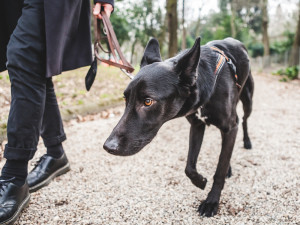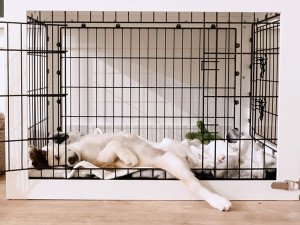Separation Anxiety in Dogs
Train your dog to stay calm when they’re on their own – instead of sad-singing “All By Myself” until you come home.

Share Article
The COVID-19 pandemic started four years ago, and although initially it meant we were locked up inside, in the time since we've gotten used to terms like “hybrid working”, which means we now do have to leave the house sometimes. Some companies have even gone the whole hog and now require their employees to be back in the office full-time. Whatever your reality, your pandemic pup probably doesn’t see you as much as they used to, and it stresses them out. It’s beyond time to start separation anxiety training with your dog.
What is separation anxiety in dogs?
Separation anxiety is a common behavioural disorder in dogs that occurs when a dog experiences panic or fear when they’re left alone. It can be treated with enrichment, training and medication. It’s important to be patient and consistent because treatment can take time. If you are struggling to help your dog, consider working with a certified professional dog trainer or behaviourist.
How does separation-anxiety training work?
When someone is scared — dogs, cats, people, you name it — you can teach them to overcome their fear by using a behavioural psychology process called systematic desensitisation. Basically, you introduce the thing that is scary but at a level that is not scary.
So, if you want to help your dog overcome their fear, you’d first need to figure out how far away they can be from whatever is causing their fear without being scared. Let’s say that distance is 10 feet away. That means you’d start your training at 10 feet away when your dog is completely relaxed. Great. Let’s see if you can inch a little closer. Nine feet away – still no problem. Eight feet – you’re good. Seven feet – gulp! Way too close. Let’s back ’er up a bit… 7.5 feet – all good. Little by little, you move closer, but only as long as your pup still feels fine. The key is controlling that distance so that they can always feel safe.
Understanding separation anxiety in dogs
Let’s apply this to dogs who are scared to be alone now. Pups are not dummies. They’ve figured out that every time the keys make that jingly sound or the jacket goes on, their people leave through that door, and their terror begins. They tell us they’re anxious by giving us signals.
Dogs with separation anxiety will whimper, stiffen, yawn, lick their lips, bark, howl, jump up to the door knob, scratch and chew the door (or the frame and the floor), lose their bladders or break out of their crates and cut themselves in the process.
All of those behaviours are rooted in fear. Notice how your dog does not do that when someone else is there? They’re scared when they’re alone, and so if you stop scaring them, the ‘bad’ behaviours go away, too.
How to train a dog with separation anxiety
Rather than thinking of separation anxiety-training as something to “teach your dog that you always come back,” think of it as training to “teach your dog that nothing bad ever happens when you walk out the door.” In order to do that, you have to watch their body language to control how long you are gone.
1. Find your starting point
When you turn your door knob, does your dog fly to the door? If so, don’t turn the door knob yet. Just walk to the door and go back and sit down. Can you open the door halfway, but all the way is too far? Fine, only open it halfway until your dog doesn’t even look up when you go to do that. Can you stand outside with the door closed for one second, but two seconds is too long? OK! Great info. Keep it under two seconds. Get the idea?
2. Build their tolerance
Pick one or two times a day to do 30 minutes of alone-time exercises, five to six days a week. Practice the actions leading up to leaving your dog alone to teach your pup there is nothing to fear. You’ll do this by grabbing the keys, turning the door, or walking to the door – whatever their tolerance level is. Don’t push them; ensure their body language stays positive. The goal is to show them it’s safe.
3. Wait one to two minutes between each attempt
Make sure your dog is totally relaxed before you leave again. If you leave while they're still excited about your previous return, they will be too aroused for the next trial and have less tolerance, which could make the issue worse (not better).
4. Watch for signs of stress
If your dog is panting, yawning, salivating, pacing or trembling, they are too stressed for you to continue. Back up and shorten how long you leave them alone until they are relaxed again. Then continue building up their tolerance – slowly.
5. Provide physical and mental stimulation when you’re home
As the old saying goes, “A tired dog is a good dog. Exercising your dog’s body and mind is a good way to decrease their stress so they're less anxious when you leave the house. Make sure your dog is getting plenty of exercise, and play fun, interactive games with them.
Keep training as they get better.
As your dog gets used to simple acts like walking to the door and touching the handle, introduce departure-related objects (keys, jackets, purse) one at a time. Mix up the training regime with easy and more complex tasks. For example, walk to the door and turn the handle halfway; other times, grab your jacket and put on your shoes before doing so.
Teach your dog that nothing bad ever happens when you walk out the door before anything bad does happen. Up to 55 percent of dogs worldwide exhibit some kind of separation-related problem, so why risk that happening to your dog, too? Tackle the issue before it becomes a problem.
Frequently asked questions
Can you crate train a dog with separation anxiety?
It depends. If your dog feels that their crate is their safe place, then crate training should work for them. If your dog shows signs of distress in their crate, it's probably not a good idea.
Can hiring a dog trainer help with separation anxiety?
Yes, hiring a dog trainer or animal behaviourist can help improve your dog's separation anxiety.
Resources:

Tracy Krulik, CTC, CSAT
Tracy Krulik, CTC, CSAT, is a Northern Virginia-based certified canine separation anxiety trainer and honors graduate of Jean Donaldson’s prestigious Academy for Dog Trainersopens in new tab. Krulik is also the founder and managing editor of iSpeakDogopens in new tab — a website and public awareness campaign to teach dog body language and behavior.
Related articles

FYI, Your Dog Can’t Stand When You Do These 7 Things
Trust me, I’m a dog trainer

8 Tips for Helping an Anxious Dog
Easy ways to calm your pup’s nerves

How to Keep Your Dog From Freaking Out When You Have Company
Do these things to help your pup (and your guests) feel chill

How to Help an Anxious Dog Conquer Their Fears
Six animal behaviourists share pro tips for boosting the confidence of a fearful dog

Your New Dog is Scared of You. Now What?
Five ways to warm a skittish dog to you

Understanding Reactivity and Aggression in Dogs: Two Very Different Things
Apparently even experts have a hard time defining these terms



